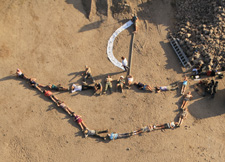Area C

Excavation
1980 - 1981 by New York University (dir. Lawrence Schiffman) and Hebrew University (area supervisors - Ilan Sharon Shalom Yankelevitch, James Quartermain and Yosef Levi). 1982 - 1983 Hebrew University, supervised by Ilan Sharon, Dina Kauphman and Orna Cohen. In 1984 - 1987 a section was cut through the eastern fortification systems at the eastern edge of the area (C1), supervised by Lynn Banks, Gilah Gross and Adrian Boas.
Publication
Vol. 1-2 of the final report.
Stratigraphic sequence
Roman Period
Strata I-II (local phases C0/2, C1/1, C2/2a-c): These mark the last use of the three insulae. The two streets - street I, between C0 and C1 (traced through areas A B and C) and street II, between insulae C0 and C2 - were paved and connected to a central drainage system. A section of the lower city at the foot of the mound also dates to this period.
Hellenistic Period
 Strata III and IV (local phases C0/3-4, C1/2-3, C2/2d-3): This is the best
preserved architecture in area C, and Hellenistic insula C0 can still be
seen on site. East of it a long stretch of the city wall was revealed, probably
built by the Ptolemais, and a square tower was excavated east of insula C1.
Insula, C0, comprised several residential units, built with fine ashlar
masonry, on the west side of Persian - Roman street I.
Strata III and IV (local phases C0/3-4, C1/2-3, C2/2d-3): This is the best
preserved architecture in area C, and Hellenistic insula C0 can still be
seen on site. East of it a long stretch of the city wall was revealed, probably
built by the Ptolemais, and a square tower was excavated east of insula C1.
Insula, C0, comprised several residential units, built with fine ashlar
masonry, on the west side of Persian - Roman street I.
Intermediate Persian/Hellenistic horizon
Stratum V (local phases C0/5, C1/4, C2/4-5): The most significant remains of this phase are found in area C1, east (outside) of the later fortification wall. Residential houses are built right up to the edge of the tell, the outer walls of the insula serving as a fortification of sorts. There is marked continuity within this period - in architecture, pottery and small finds - and distinguishing between the late Persian and the early Hellenistic eras is quite difficult.
Earlier Persian Period
Stratum VI (local phases 6/C0, 5a/C1, 6/C2): The sequence of fortifications in area C1 shows reuse of a composite mud-brick and stone offset-inset city wall, first built in the Iron Age. Probes in areas C1 and C0, and a well-preserved part of insula C2 indicate that all three insulae, as well as both street I and street II were already built up in this period, and though facades and inner partitions were shifted, the town plan changed little henceforward -- till the Roman era.
Iron Age 2B-C

Local phases C1/5b-6, C2/7: The main structural remains are the Ir2b - Persian offset-inset city wall in area C1, and a series of glacis-surfaces outside it. This fortification system was apparently built before the Assyrian occupation of Dor (Ir2b) and continued to be used throughout it (Ir2c). Sections of the same wall were found in area A and area B1 where it was used with two superimposed gatehouses.
Iron Age 2A
Local phase C1/7: A section of a mudbrick wall - apparently a town wall of the offset-inset type, was found in area C1 under the later glacis.
Iron Age 1
Local phase C1/8: Deposits under the mudbrick wall; no structural remains.
